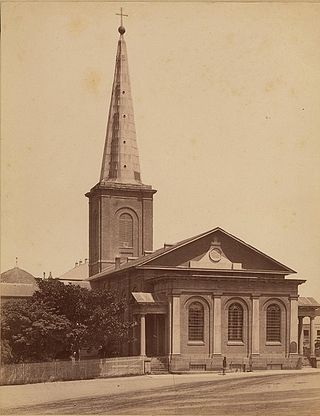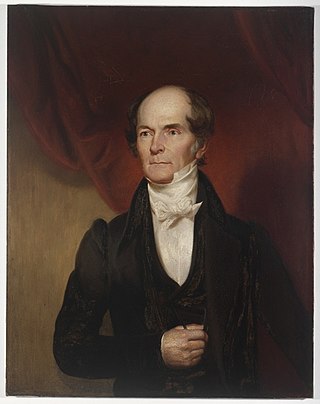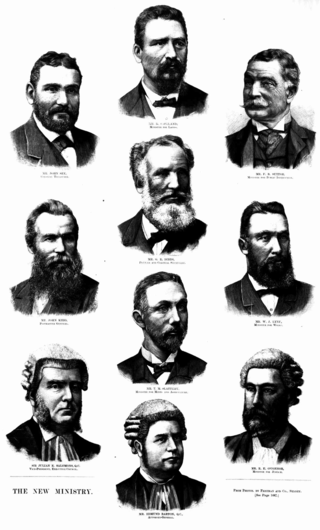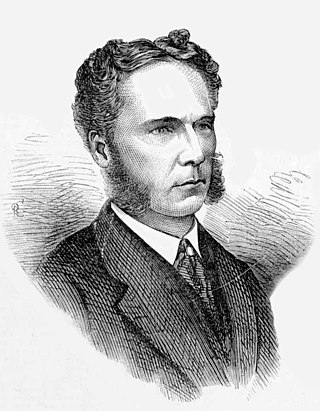
Major General Sir Thomas Makdougall Brisbane, 1st Baronet,, was a British Army officer, administrator, and astronomer. Upon the recommendation of the Duke of Wellington, with whom he had served, he was appointed governor of New South Wales from 1821 to 1825.

Sir Samuel Walker Griffith was an Australian judge and politician who served as the inaugural Chief Justice of Australia, in office from 1903 to 1919. He also served a term as Chief Justice of Queensland and two terms as Premier of Queensland, and played a key role in the drafting of the Australian Constitution.
Each Australian state has a governor to represent Australia's monarch within it. The governors are the nominal chief executives of the states, performing the same constitutional and ceremonial functions at the state level as does the Governor-General of Australia at the national or federal level. In practice, with notable exceptions the governors are generally required by convention to act on the advice of the state premiers or the other members of a state's cabinet.

The Federation of Australia was the process by which the six separate British self-governing colonies of Queensland, New South Wales, Victoria, Tasmania, South Australia, and Western Australia agreed to unite and form the Commonwealth of Australia, establishing a system of federalism in Australia. The colonies of Fiji and New Zealand were originally part of this process, but they decided not to join the federation. Following federation, the six colonies that united to form the Commonwealth of Australia as states kept the systems of government that they had developed as separate colonies, but they also agreed to have a federal government that was responsible for matters concerning the whole nation. When the Constitution of Australia came into force, on 1 January 1901, the colonies collectively became states of the Commonwealth of Australia.

The Colony of New South Wales was a colony of the British Empire from 1788 to 1901, when it became a State of the Commonwealth of Australia. At its greatest extent, the colony of New South Wales included the present-day Australian states of New South Wales, Queensland, Victoria, Tasmania, and South Australia, the Northern Territory as well as New Zealand. The first "responsible" self-government of New South Wales was formed on 6 June 1856 with Sir Stuart Alexander Donaldson appointed by Governor Sir William Denison as its first Colonial Secretary.

Chief secretary was the title of a senior civil servant in various colonies of the British Empire. Prior to the dissolution of the colonies, the chief secretary was the second most important official in a colony of the British Empire after the Governor, typically termed the colonial secretary and often an office held by the premier or a similar politically elected minister, and with a portfolio which were equivalent to what was later termed the Home Secretary's office.

John Thomas Bigge was an English judge and royal commissioner. He is mostly known for his inquiry into the British colony of New South Wales published in the early 1820s. His reports favoured a return to the harsh treatment of convicts and the utilisation of them as cheap agricultural labour for wealthy sheep-farming colonists. Bigge's reports also resulted in the resignation of Governor Lachlan Macquarie whose policies promoted the advancement of ex-convicts back into society.

The New South Wales Government Architect, an appointed officer of the Government of New South Wales, serves as the General Manager of the Government Architect's Office (GAO), a multi-disciplinary consultancy operating on commercial principles providing architecture, design, and engineering services, that is an agency of the government within NSW Public Works.

Arthur Macalister, was three times Premier of Queensland, Australia.

Sir Arthur Hodgson KCMG was an Australian pioneer and politician.

Sir Francis William Forbes was a Chief Justice of Newfoundland, and the first Chief Justice of New South Wales.

The New South Wales Minister for Education and Early Learning is a minister in the New South Wales Government and has responsibilities that includes all schools and institutes of higher education in New South Wales, Australia.

The third Dibbs ministry, the 27th ministry of the Colony of New South Wales, was led by Sir George Dibbs, leader of the Protectionist Party, following the 1891 New South Wales election, which saw the Labour Party win seats in the New South Wales Legislative Assembly and the balance of power. With no party having a majority, Sir Henry Parkes held on as Premier until October 1891 when he lost a vote in the Legislative Assembly, causing Parkes to resign as Premier and leader of the Free Trade Party. Dibbs formed the ministry on 23 October 1891, with Labour support, and comprised 10 ministers.

The Postmaster-General of New South Wales was a position in the government of the colony of New South Wales. This portfolio managed the postal department of the New South Wales Government and was in charge of all postal and communications services in the colony prior to the Federation of Australia, from 1835 to 1901. Upon Federation, Section 51(v) of the Constitution of Australia gave the Commonwealth exclusive power for "postal, telegraphic, telephonic, and other like services".
Frederick Goulburn was a British army officer and the first Colonial Secretary of New South Wales.

The New South Wales Minister for Aboriginal Affairs is a minister in the Government of New South Wales with responsibility for administering legislation and policy in relation to that state's indigenous Australians in the state of New South Wales, Australia.

Sir Joseph George Long Innes, was a judge and politician in colonial Australia, and Attorney General of New South Wales from 1873 to 1875.

The Separation of Queensland was an event in 1859 in which the land that forms the present-day State of Queensland in Australia was excised from the Colony of New South Wales and created as a separate Colony of Queensland.

The Minister for Lands and Property, also called the Secretary for Lands was responsible for one of the key issues for the colonial administration of New South Wales, being the contest between squatters and selectors to dispossess the Aboriginal people of their land.

The Secretary for Lands and Works was one of the first ministries in the colonial administration of New South Wales following the establishment of responsible government in 1856.

















